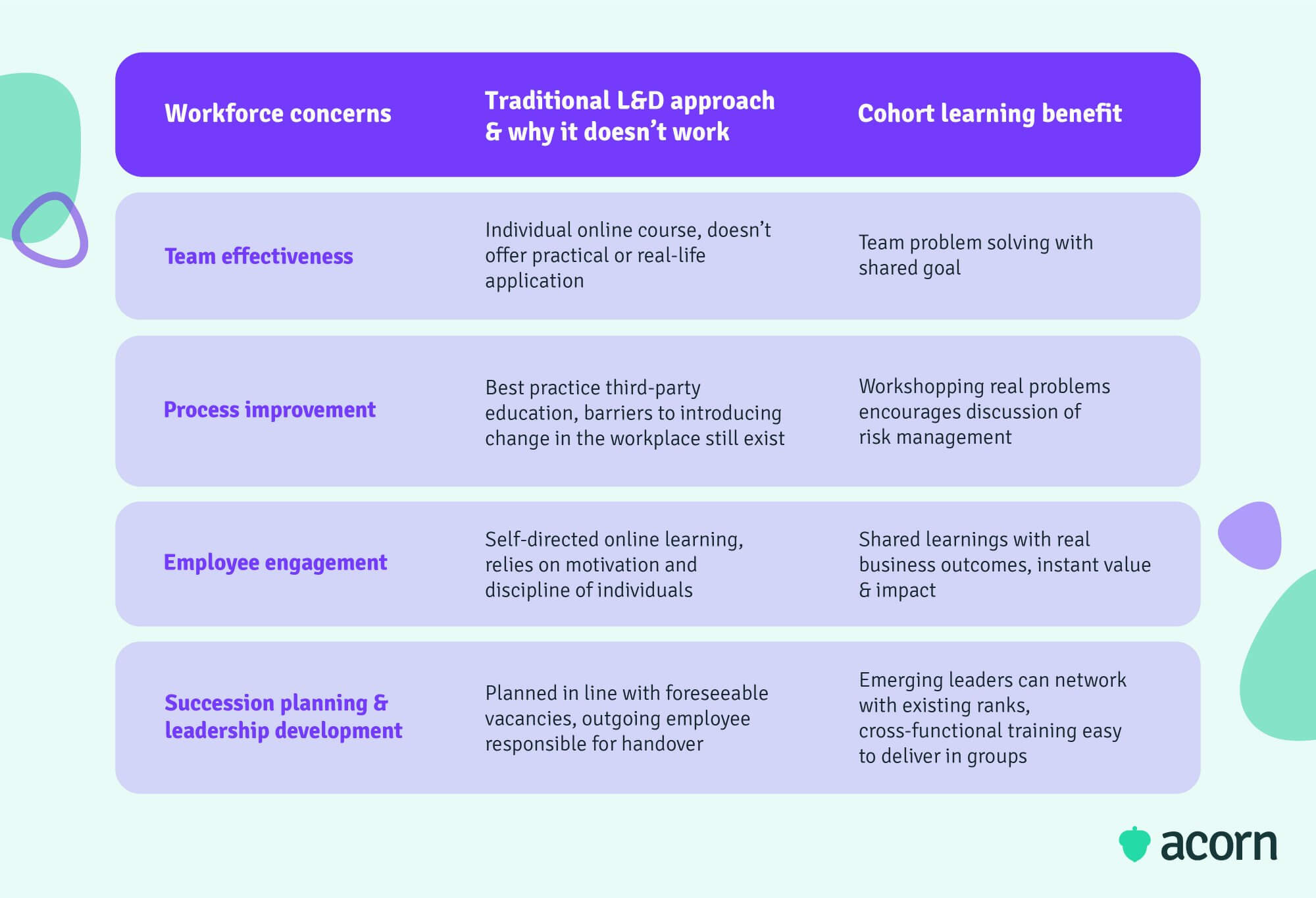How Cohort Learning is Changing the Game for Future Leadership
Reading Time:

Lead the pack with the latest in strategic L&D every month— straight to your inbox.
SubscribePlenty of L&D buzzwords eventually catch on to be bigger than a trend. See: Corporate university, microlearning, cohort learning.
That last one has been on the rise, though that doesn’t mean it isn’t worth including in a corporate learning strategy.
The goal of cohort-based learning is to utilise a shared goal and outcomes to drive more impactful and engaging learning. But is the cohort learning hype actually worth it? How do you make it work for online education? We cover it all in this blog.
What is cohort-based learning?
Cohort learning is a collaborative style of learning in which a group of learners undertake a training program together.
As opposed to self-paced learning, where learners undertake solo learning at their own pace, participants in cohort-based learning actively engage in shared learning activities within a fixed period of time.
Who uses cohort learning?
Cohort-based learning has its roots in massive open online courses (or MOOCs), which were initially a way for individuals to access online education through schools and universities.
It’s since made its way to corporate training, where an individual approach—while personalised—doesn’t always guarantee engagement with business-critical training. L&D leaders are starting to see how leveraging shared learning goals can reflect the team dynamic in the workplace.
With this in mind, cohort learning in the workplace is a scalable way to deliver on:
- Team effectiveness
- Process improvement
- Employee engagement
- Succession plans
- Leadership development.
Supporting strategic L&D at scale is a big part of the thinking behind our performance learning management system (PLMS). Using capabilities as the blueprint for development, Acorn PLMS enables you to create truly impactful learning experiences mapped directly to the capabilities of learners’ job roles. Not only does that ensure you’re serving up contextual (and therefore impactful) L&D (be that cohort learning or supplementary courses), but it enables you to show direct causation between L&D and organisational performance.
What are the benefits of cohort learning for future leaders?
Let’s narrow in on those last two bullet points. We’ve discussed before how the higher up leaders go, the less support they traditionally receive. That affects your talent pipeline with leaders that may be less confident, innovative or informed than you need—which only trickles down into your workforce.
Self-paced learning isn’t the bone to throw here, especially in online learning environments. But cohort-based learning works because it:
- Is scalable
- Keeps busy leaders accountable
- Has a tangible business impact
- Creates networks.
Scalable
The leadership pipeline never stops (and should never stop) moving. Cohort-based learning provides a fast, scalable and cost-effective way to continually nurture that pipeline in a consistent way. Particularly if you’re using online courses throughout the learning program, you can generally account for the costs involved in expanding or decreasing the number of learners in line with succession plans, while updating content en masse.
Accountability
Hear us out for a second.
Many talent decisions are made on potential. Recruitment, promotions, succession. But potential is only a lagging indicator in the grand talent scheme, which means that consistent performance enhancements are going to divulge the true leading indicators in your workforce.
Keeping employees accountable for training is the next step. Creating a shared goal through cohort-based learning is one way to circumvent inconsistent learning and its ramifications, since it positions the group against the problem.
So, accountability is twofold.
- Employees are held to account, because if one person slacks off, the whole group feels it.
- Organisations are accountable for creating impactful programs that incite engagement to begin with.
Impact
Strategically impactful L&D needs to be impactful for employees, too. Action learning programs are part and parcel of cohort learning that provide immediate feedback and relevance for participants. Tie them to business needs and their day-to-day priorities, like a leadership development workshop for new leaders that covers conflict resolution scenarios.

Networking
They say it’s not what you know, but who you know. It doesn’t ring untrue, particularly when leaders are looking for mentors or potential recruits and partnerships down the line.
Building a network is a happy side effect of cohort learning. You could create a course for leaders across business functions who may not interact otherwise, which in turn creates stronger connections within your organisation.
What is a cohort-based course?
Cohort-based courses are learning activities organised around a central topic, agenda or syllabus for a group of employees. A cohort-based course can be delivered as part of an online program, blended learning or face to face, depending on the learning experience required.
How to build a cohort-based course
Compared to the self-paced course, a cohort-based course requires a little more work in the alpha phase.
Though the goal is to achieve a core set of learning outcomes, you have to factor in the differences in schedules, experience and personalities of your cohort—as well as the current or emerging business opportunities you need the course material to address.
For some guidance, cohort-based learning courses should have the following elements:
- Guided learning sessions
- Assignments and active learning
- Group communication
- Real-world outcomes.
Create a training curriculum
First port of call: What will the course curriculum be? To answer this, we must ask another question: What challenges are affecting a portion or all of your workforce?
Understanding the pain point you’re solving or opportunity to exploit will give you the target cohort group. To ensure that learners are experiencing the benefits of cohort-based programs, you’ll want to take on the right roles and people to learn the intended outcomes.
Part of building the training curriculum is creating both learning objectives and learning outcomes.
- Objectives are essentially the milestones and touch points learners need to hit during cohort-based learning programs. These are generally tied to facilitators or instructors over learners, as a measure of what they want to accomplish.
- Outcomes are what learners are meant to have gained at the end of a course. Knowledge, skills, behaviours—whatever it is, an outcome can be tangibly measured.
Think of them co-dependently. Objectives will translate to outcomes if the course runs as intended.
For example, say you’ve got an organisation that’s introducing a leadership tier for the first time as it scales its teams. The workforce is young and none of the emerging leaders have people management experience.
The pain point is a need for vanguards of strategy with strong leadership capabilities. This gives facilitators or L&D leads information with which to plan:
- Content, supplemental resources and follow-up content
- Timelines, specifically time blocks for group sessions and deadlines for assignments
- Methods of assessment, include formal and informal feedback and grading guidelines in line with outcomes
- Budget allocations. If using a cohort-paced online course, business resources will also have to be diverted to account for the time employee take away from projects.
Identify the best format
There are plenty of ways to model a cohort environment.
- Self-paced theory with group action
- Entirely instructor-led
- Facilitator scenario
- Group work only.
Then there’s the online course vs face-to-face debate. If the entire cohort works in the same office, face-to-face is likely a more conducive option for connection. But if the cohort is dispersed, a virtual environment is going to be the feasible pick.
If you’re going online, the breadth of content widens for you. The challenge is finding relevant content, which is where a PLMS can be handy. Many traditional learning management systems fall victim to a Netflix-like learning environment, but a PLMS with the right content discovery functionality will make it easier to segment information by capabilities or topic.
It segues into your productivity tools, too. A facilitator can only do so much with group work and then the rest is up to the group themselves. While you can’t be 100% sure they’ll stick to it, make rough plans for learners to interact and discuss coursework outside of schedule sessions. Why does this matter? Because it encourages employees to talk about how to apply the learning to the problem at hand, rather than just as learning itself.
Microsoft Teams and Slack on their own are good, but integrated with your LMS (or PLMS) is better. It essentially allows learners to share and complete content within their messaging channels. Training sessions can be scheduled within these apps too, so it makes sense to utilise your current tech stack.
Evaluate efficacy
Traditional education and schooling generally looks to knowledge learned over behavioural change. But that’s in contrast to the KPI-based structure of most corporate learning programs.
This is where an online learning platform is also handy, given the ability to track and report on learning efficacy.
Look to elements like:
- Surveys for employee sentiment. What worked and what didn’t they like?
- Completion rates for self-paced online courses. It’ll give you an idea of what content was useful. Attendance for cohort-based online courses also gives an idea of engagement.
- Proficiencies and capability development plans that show you tangible skills learned. This point is crucial, as it can be tied to performance evaluations to determine post-training skills application.
The challenges of cohort learning in the workplace
There are some people out there who believe cohort learning is the next big thing in eLearning. While it’s something to watch out for, it’s not necessarily going to shake up your entire learning strategy.
One of the challenges of cohort-based learning programs is the structure itself. Too much structure can make for a rigid learning experience, which tells employees that their time is not valuable to you. People’s lives aren’t just going to suddenly get less complicated. Making time for cohort-based programs is still going to be a hurdle, especially the higher up your leadership pole you go.
If you’re using an online environment for your programs, the human connection may not always come through on screen. (We’ve all been in more than one Zoom meeting where people don’t turn their cameras on.) This isn’t meant to be fear mongering. If you’re aware of the limitations of this approach, you’ll be able to better incorporate it into your learning strategy.
Key takeaways
The cohort learning model isn’t going to replace self-paced courses. It’s simply a different learning process that creates a why for leaders to devote their most precious resource to L&D: Their time.
Self-paced courses don’t always have metrics or milestones attached, which can leave room for misinterpretations, which in turn can throw off the accuracy of measures of competency, capability realisation and overall job performance.
That’s not to say that cohort learning is the “better” option; personalised capability plans are important but don’t exactly lend themselves to a group setting. But work happens in teams, so it only makes sense that some part of the employee learning process happens in teams, too.